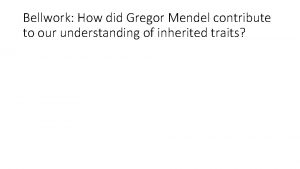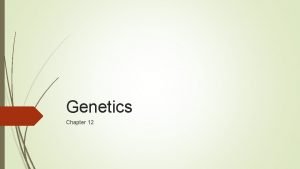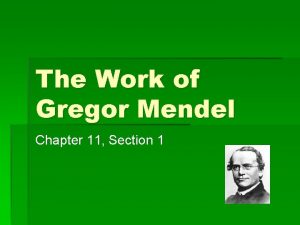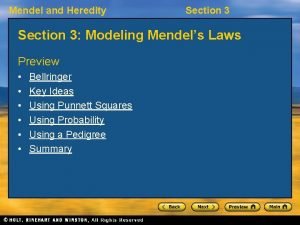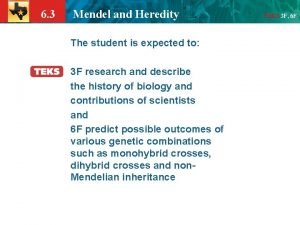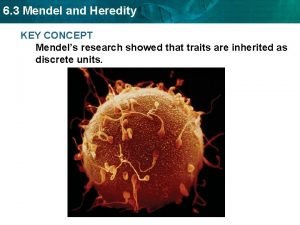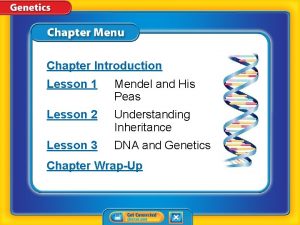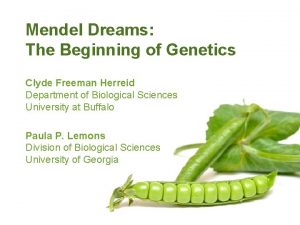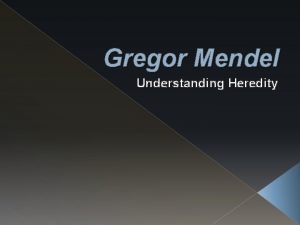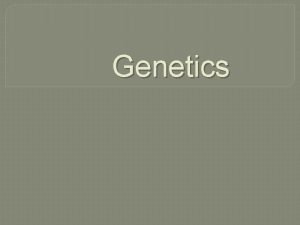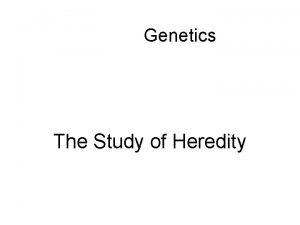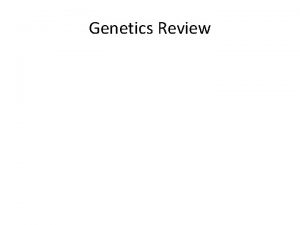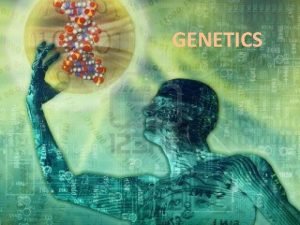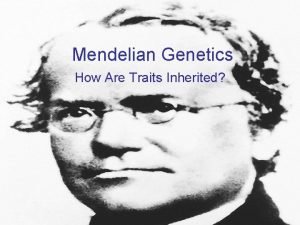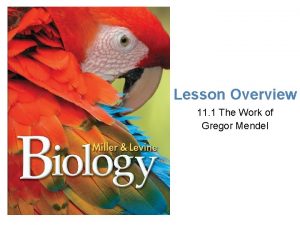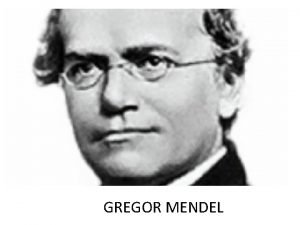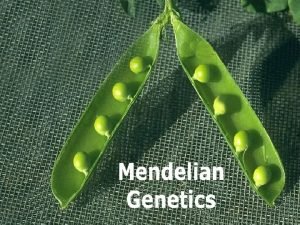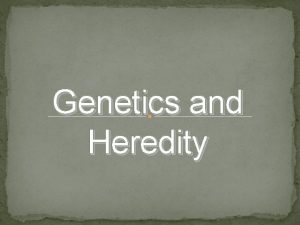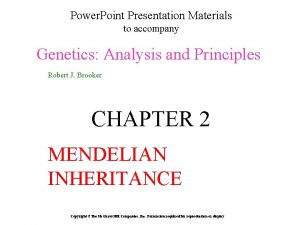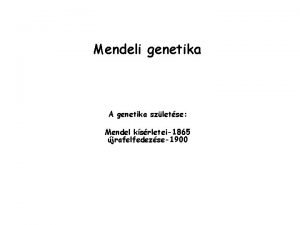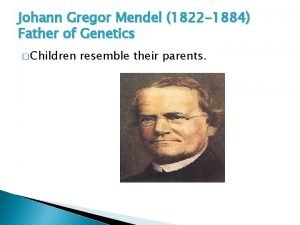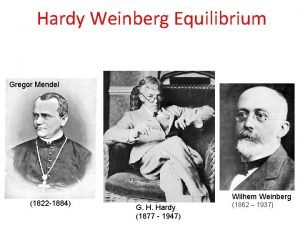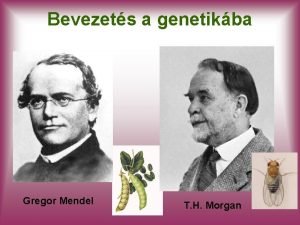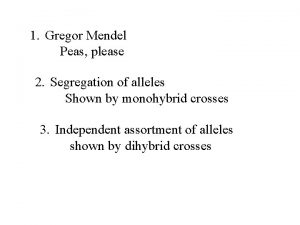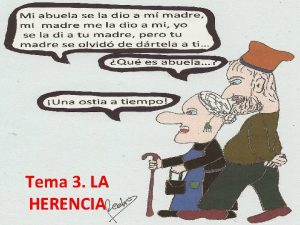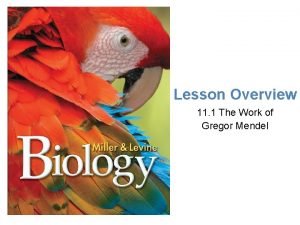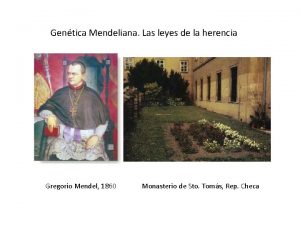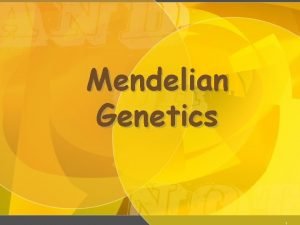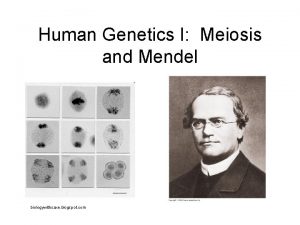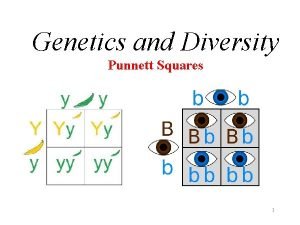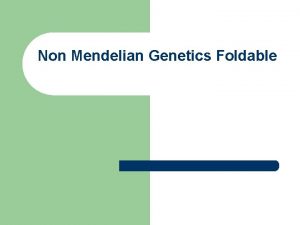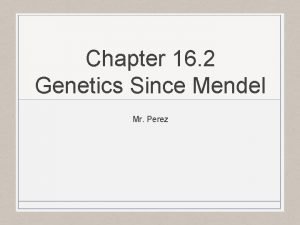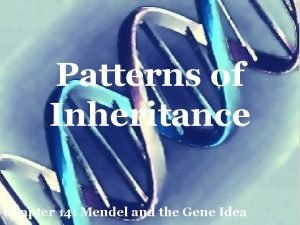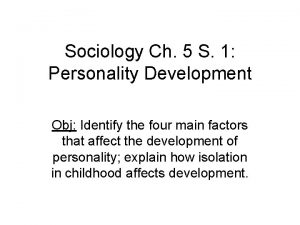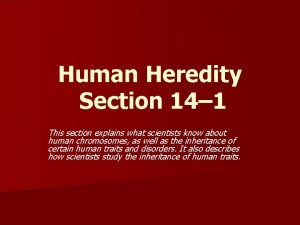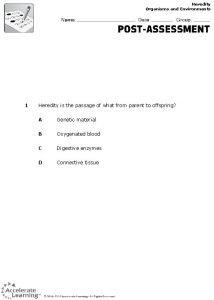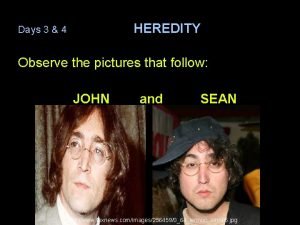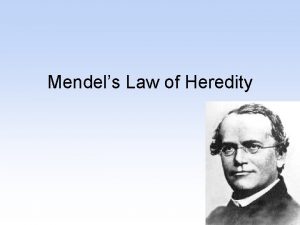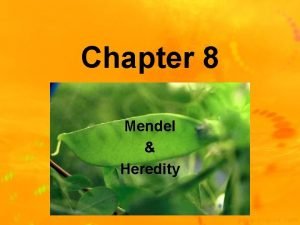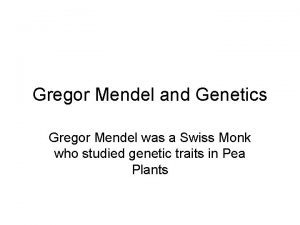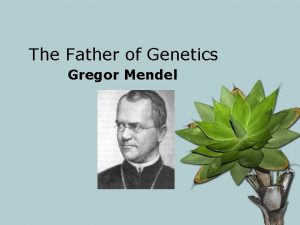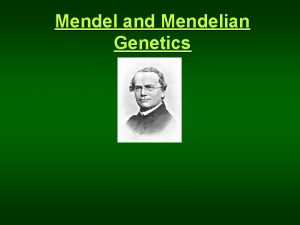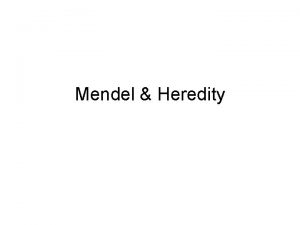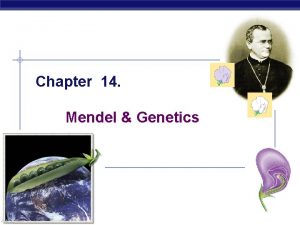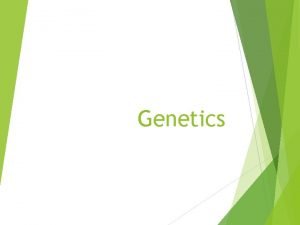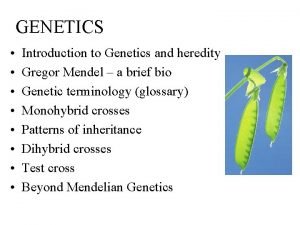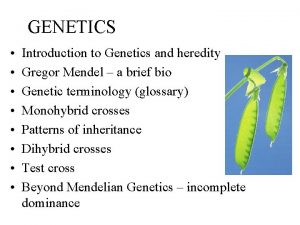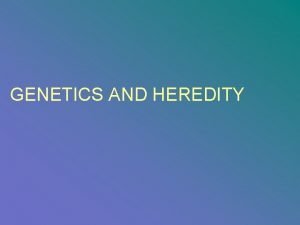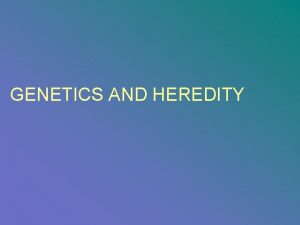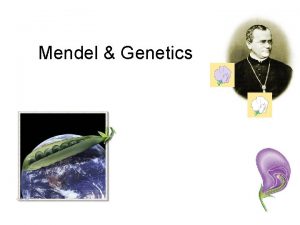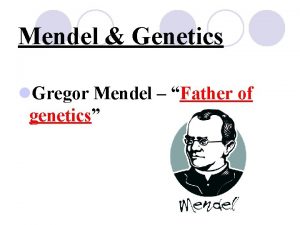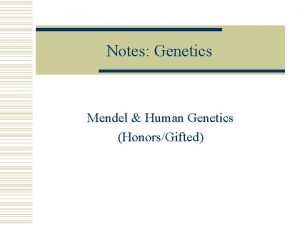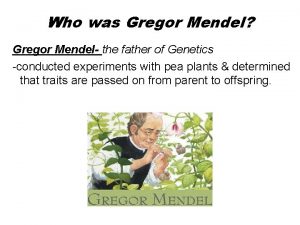Heredity Genetics Chapter 12 Gregor Mendel Worked in



































































- Slides: 67

Heredity / Genetics Chapter 12

Gregor Mendel Ø Worked in the mid-1800 s Ø Studied pea plants Ø Developed rules that accurately predict the patterns of heredity Ø Known as father of genetics for his contributions to the study of heredity.

Heredity Ø Genetics - The study of heredity. Ø Heredity - The inheritance of a set of characteristics from one’s parents. Ø The physical features that are inherited are referred to as characteristics.

Heredity Ø The units that determine biological characteristics are called genes. Ø Characteristics can show up as one of several possible forms called traits.

Traits Ø Mendel studied 7 traits of the pea plants.

Mendel’s First Experiments Ø Used a pair of contrasting traits Breeding a short plant with a tall plant, purple & white flowers, etc. l Kept all other traits the same in each plant l The resulting offspring with different characteristics are referred to as hybrids. l • These are called monohybrid crosses.

Mendel’s First Experiments Ø Followed these plants through three generations l Group of offspring from a given group of parents. • P 1 = original parents • F 1 = offspring of parents l first filial generation • F 2 = offspring of F 1 l second filial generation (filial = son/daughter)

Mendel’s First Experiments Ø P 1 = purple and white Counted the number of traits in the F 1 generation l Found F 1= all purple l

Mendel’s First Experiments Ø Crossed F 1 x F 1 Counted the number of traits in the F 2 generation l F 2 = purple and white l 3: 1 ratio l

Results Ø Tested all of the contrasting traits and compared the ratio of traits that resulted from each cross They all ended up being 3: 1

Mendel’s Conclusions Ø At the time, people thought the traits of offspring were a blend of the traits from parents. Ø Mendel’s results showed that only one of two traits (purple or white) were expressed for each characteristic.

Ø Today, we know that different traits result from different versions of genes. l Each version of a gene is called an allele.

More Conclusions Ø An offspring’s traits do not match one- to-one with the parents’ traits. Ø Offspring do not show a trait for every allele that they receive. The trait that results from a set of alleles is the phenotype. l The set of alleles that an individual has for a characteristic is called the genotype. l

Simplified…. . Ø Phenotype – an organism’s physical appearance (trait) l Ex. Purple, white Ø Genotype – an organism’s genetic composition l Ex. PP, Pp Ø Genotype determines phenotype.

Even More Conclusions Ø Mendel did not know about meiosis, but concluded that each trait (purple or white) was controlled by a pair of alleles, one from each parent. l Homozygous – same alleles • Ex. TT or tt l Heterozygous – different alleles • Ex. Tt

Ø For each pair of traits, one always seemed to “win” over the other whenever both alleles were present. Ø The other allele had no effect on the organism’s physical form. The expressed allele is called dominant. l The allele that is not expressed (hidden) when the dominant allele is present is called recessive. l

Law of Segregation Ø The two alleles separate from each other during formation of sex cells. Ø Either of these traits could end up in any gamete and chance decides which alleles will be passed on.

Mendel’s Second Experiments Ø Used the lack of pattern in this round. l Round seed did not always show up in the yellow seed trait. Ø Dihybrid cross involves two separate characteristics

Dihybrid Cross Ø A cross between individuals that involves two pairs of contrasting traits. l Homozygous round yellow x Homozygous green wrinkled • RRYY x rryy

Mendel’s Conclusions Ø The inheritance of one characteristic did not affect the inheritance of the second. Ø Law of Independent Assortment: Most genes are inherited independently and do not influence each other’s inheritance.

Probability Ø Probability: the likelihood an event will occur. Ø Probability: Number of times an event is expected to occur Number of opportunities for an event to occur Example: Seed Color l. Dominant (Yellow) occurred 6, 022 times l. Recessive (Green) occurred 2, 001 times

And the answers are…… Dominant Trait Recessive Trait 6, 022 + 2, 001 = 0. 75 or 75% Yellow = 0. 25 or 25% Green

Probability Examples In begonias, a red flower (R) is dominant to a white (r). Ø What is the probability of producing a white flower if two heterozygous plants are crossed? A red flower? Ø What is the probability of producing three white flowers in a row?

Punnett Squares Ø Biologists use a Punnett Square to predict the probability of traits which will be inherited. Ø Visual diagram that shows probability of different genotypes and phenotypes in a cross without a calculation.

Monohybrid Cross Ø A cross between two individuals involving one pair of contrasting traits. Ø What is the probability of producing a white flower if two heterozygous plants are crossed? Ø A red flower?

Practicing Punnett Squares Monohybrid Cross Tall (T) is dominant in pea plants, Short (t) is recessive. Genotype: Tt Phenotype : Tall Genotype: Phenotype: Genotype: Phenotype:

Practicing Punnett Squares Monohybrid Cross Tall (T) is dominant in pea plants, Short (t) is recessive. Genotype: TT Phenotype : Tall Genotype: Tt Phenotype : Tall Genotype: Phenotype: Genotype: Phenotype:

Practicing Punnett Squares Monohybrid Cross Tall (T) is dominant in pea plants, Short (t) is recessive. Genotype: TT Phenotype : Tall Genotype: tt Phenotype : Short Genotype: Phenotype: Genotype: Phenotype:

In guinea pigs, black coat color (B) is dominant over brown coat color (b) 1. A homozygous dominant (BB) guinea pig is crossed with a homozygous recessive(bb) guinea pig. a. What is the phenotype of the F 1 offspring? b. What is the genotype of the F 1 offspring?

B = black b = brown 2. A homozygous dominant (BB) guinea pig is crossed with a heterozygous (Bb) guinea pig. a. What is the phenotype of the F 1 offspring? b. What is the genotype of the F 1 offspring?

B = black b = brown 3. A homozygous recessive guinea pig is crossed with a heterozygous guinea pig. a. What is the phenotype of the F 1 offspring? b. What is the genotype of the F 1 offspring?

B = black b = brown 4. A heterozygous guinea pig is crossed with a heterozygous guinea pig. a. What is the phenotype of the F 1 offspring? b. What is the genotype of the F 1 offspring?

Ratios of offspring Ø Genotypic ratio: The ratio of genotypes which occur in the offspring. l HW #4 = 1 BB : 2 Bb : 1 bb Ø Phenotypic ratio: The ratio of phenotypes which occur in the offspring. l HW #4 = 3 black : 1 brown

Genotypic Ratio Phenotypic Ratio 1 TT : 2 Tt : 1 tt 3 tall : 1 short Heterozygous tall Genotype: Genotype: Phenotype:

Genotypic Ratio Phenotypic Ratio 2 TT : 2 Tt 4 tall : 0 short Homozygous tall Genotype: TT Heterozygous tall Genotype: Tt Genotype: Phenotype: Genotype: Phenotype:

Homework Tonight 1/18 Complete the genotypic and phenotypic ratios (c – d) for the guinea pig problems.

Dihybrid Cross Ø Dihybrid crosses show the probabilities when you cross two traits. l Option 1: Use Punnett Squares and Rule of Multiplication to solve OR l Option 2: Use Larger Punnett Square to solve.

Dihybrid Crosses Option 1 Ø Make a Punnett Square for each gene, then use rule of multiplication. Ø In plants, round seeds (A) are dominant to wrinkled (a) and yellow seeds (B) are dominant to green (b). Parent 1 is heterozygous round, yellow l Parent 2 is heterozygous round, yellow l What is the probability that their offspring will be Aa. Bb?

Dihybrid Cross Option 1 Continued A A AA a Aa aa B B BB b Bb Probability of Aa = ½ b Bb bb Probability of Bb = ½ Rule of Multiplication ½x½=¼ Probability of offspring Aa. Bb = ¼

Dihybrid Cross Option 2 Ø Make one big punnett square to show all possible combinations. Ø An Example: l Parent 1 is Aa. Bb • Possible gametes = AB, Ab, a. B, or ab l Parent 2 is Aa. Bb • Possible gametes = AB, Ab, a. B, or ab

Dihybrid Cross Parents AB Ab a. B ab AB AABb Aa. BB Aa. Bb Ab AABb AAbb Aa. Bb Aabb a. B Aa. Bb aa. BB aa. Bb ab Aa. Bb Aabb aa. Bb aabb Probability of offspring Aa. Bb = 4/16 or ¼

Dihybrid Cross Ratios Ø Genotypic: l 4 Aa. Bb : 2 AABb : 2 Aabb : 2 Aa. BB : 2 aa. Bb : 2 aabb : 1 AABB Ø Phenotypic: l 9: 3: 3: 1 • 9 round, yellow : 3 round, green : 3 wrinkled, yellow : 1 wrinkled, green

Human Somatic Cells Ø Human somatic cells have a total of 46 chromosomes— 23 from each parent l These cells contains 44 autosomes (22 pair). • Autosomes are chromosomes that do not determine gender. l Each cell has 2 sex chromosomes. • Females are XX • Males are XY.

Human Reproductive Cells Ø Sperm and Egg are haploid and contain 23 chromosomes. l Form a zygote during fertilization with 46 chromosomes. Ø Gender is determined by sex chromosomes. Egg always carries X chromosome. l Sperm can carry X or Y l • If X, offspring will be XX = female. • If Y, offspring will be XY = male.

Pedigrees Ø A pedigree is a chart that follows the inheritance of a single trait through several generations of a family. l Simple way to model inheritance Ø Can be used to determine inheritance pattern and predict future inheritance. l Answer questions about sex linkage, dominance, and heterozygosity. • Carrier: has allele for genetic disorder but does not show symptoms.

Example Pedigree I 1 2 II 1 2 3 4 III 1 2

Pedigrees Ø Squares represent males; circles represent females. Ø Shaded shapes indicate presence of trait. Ø Horizontal lines connect parent to each other. Ø Vertical lines connect parents to their children (arranged L R birth order).

Pedigrees Ø Brackets across top connect siblings. Ø Roman numerals are often used to show generations. Ø Sometimes lines must be drawn to show unusual relationships.

Sex-Linked Inheritance Ø Sex-linked genes l Genes located on the sex chromosomes X and Y. Ø Most sex-linked genes are on the X chromosome. Ø Recessive disorders on the X chromosome affect males more than females because females can be carriers without having the disorder.

Sex-Linked Disorders Colorblindess Ø Gene for color vision is located on the X chromosome. Dominant allele gives normal vision. l Recessive alleles produce colorblindness l Ø 10% of males in US suffer from at least one form of colorblindness

Colorblindness XBXB – Normal female XBXb – Normal (carrier) female Xb. Xb – Colorblind female XBY – Normal male Xb. Y – Colorblind male

Red-Green Colorblindness

Red-Green Colorblindness

Red-Green Colorblindness

The individual with normal color vision will see a 5 revealed in the dot pattern. An individual with Red/Green (the most common) color blindness will see a 2 revealed in the dots.

Alternative Inheritance

Incomplete Dominance Ø Genetic condition in which neither allele is completely dominant or recessive l Snapdragons • RR = red. • rr = white. • Rr = pink.

Incomplete Dominance Ø Parent 1 is red and Parent 2 is white. Ø Write genotypic and phenotypic ratios for the offspring. R R r r Rr Rr Phenotypic 0 Red : 4 Pink : 0 White Genotypic 0 RR : 4 Rr : 0 rr

Codominance Ø Condition in which both alleles of a gene are expressed equally. l Neither is dominant, nor do they blend. Ø Example: Chickens l FB - Black Feathers • A chicken that is FB FB will have all black feathers l FW - White Feathers • A chicken that is FW FW have all white. l But, a chicken that is FB FW will have black and white feathers.

Codominance Example Ø Parent 1 has black feathers; Parent 2 has black and white feathers. Ø What is the probability that these parents will have offspring with all white feathers? FB FB 0% will have all white feathers. FB FB FB FW

Polygenic Traits Ø Traits that are controlled by more than one gene Ø Inheritance is complicated and the traits show a very wide range of phenotypes l Ex. Skin color in humans

Multiple Alleles Ø A gene with more than 2 possible alleles. Ø Multiple alleles on Chromosome #9 control the ABO blood groups. l Three alleles IA, IB, and i • IA & IB are codominant, • Both dominant over i. l Result in 4 blood phenotypes • A, AB, B, and O

Blood Type Example Ø Parent 1 is heterozygous Type A. Parent 2 is homozygous Type B. Ø What is the probability that they will have a child with blood type B? IA i IB IA IB IB i 50% for Type B child

Blood Types Ø Another blood group factor is Rh, which is determined by dominant / recessive alleles • R = positive allele • RR = Positive • Rr = Positive • r = negative allele • rr = Negative

Blood Types in Humans Ø Based on antigens on the surface of RBC’s Ø If the body does not recognize the antigen, antibodies attack it and try to destroy it.

Donors and Receivers Type A blood has the antibody for type B blood, so it can’t receive blood from type B or AB donors. Ø Type O is the universal donor because it contains no antigens. Ø Type AB is the universal receiver because it contains no antibodies. Ø

Blood Group Alleles Can Donate To Can Receive From A IA IA or IA i A and AB A and O B IB IB or IB i B and AB B and O AB IA IB AB A, B, AB, O O ii A, B, AB, O O
 Gregor mendel a monk
Gregor mendel a monk Chapter 11 biology review answers
Chapter 11 biology review answers How did gregor mendel contribute to genetics
How did gregor mendel contribute to genetics Chapter 17 the beginning of the life cycle
Chapter 17 the beginning of the life cycle Chapter 12 lesson 1 the work of gregor mendel
Chapter 12 lesson 1 the work of gregor mendel The work of gregor mendel lesson 1 chapter 12
The work of gregor mendel lesson 1 chapter 12 Chapter 11 the work of gregor mendel
Chapter 11 the work of gregor mendel Section 3 mendel and heredity
Section 3 mendel and heredity Section 3 mendel and heredity
Section 3 mendel and heredity Mendel 9 3 3 1
Mendel 9 3 3 1 Section 3 mendel and heredity
Section 3 mendel and heredity Section 3 mendel and heredity
Section 3 mendel and heredity Genetics is the study of heredity
Genetics is the study of heredity Solid
Solid Who is gregor mendel and what is he famous for
Who is gregor mendel and what is he famous for Section 11-1 the work of gregor mendel
Section 11-1 the work of gregor mendel Austrian genetic traits
Austrian genetic traits Gregor mendel's dream was to?
Gregor mendel's dream was to? Gregor mendel chart
Gregor mendel chart Suit separate
Suit separate What did gregor mendel research
What did gregor mendel research Y chromosome traits
Y chromosome traits What did gregor mendel do
What did gregor mendel do Gregor mendel conclusion
Gregor mendel conclusion Gregor mendel punnett square
Gregor mendel punnett square Who was mendal
Who was mendal Gregor mendel
Gregor mendel Gregor mendel summary
Gregor mendel summary Johann gregor mendel steckbrief
Johann gregor mendel steckbrief Mendel's law of independent assortment and segregation
Mendel's law of independent assortment and segregation Who is gregor mendel and what did he do?
Who is gregor mendel and what did he do? Gregor mendel referat
Gregor mendel referat Gregor mendel
Gregor mendel Austrian monk gregor mendel
Austrian monk gregor mendel Mendel traits
Mendel traits Gregor mendel laws
Gregor mendel laws Gregor mendel laws
Gregor mendel laws Gregor mendel munkássága
Gregor mendel munkássága Gregor mendel 1865
Gregor mendel 1865 Gregor mendel
Gregor mendel Hardy weinberg equilibrium expected values
Hardy weinberg equilibrium expected values What is the phenotype of a chicken with the genotype fbfw?
What is the phenotype of a chicken with the genotype fbfw? Gregor mendel
Gregor mendel Gregor mendel
Gregor mendel Fr gregor mendel
Fr gregor mendel Blood types
Blood types Formulacion de la teoria cromosomica de la herencia
Formulacion de la teoria cromosomica de la herencia Gregor mendel
Gregor mendel Gregor johann mendel
Gregor johann mendel Gregor mendel
Gregor mendel Gregor mendel herencia
Gregor mendel herencia Gregor mendel mbti
Gregor mendel mbti Austrian monk
Austrian monk Gregor mendels principles of genetics apply to
Gregor mendels principles of genetics apply to Independent assortment in metaphase 1
Independent assortment in metaphase 1 Punnet square
Punnet square Mendel's genetics foldable
Mendel's genetics foldable Genetics since mendel
Genetics since mendel Chapter 11 human heredity section 11-3
Chapter 11 human heredity section 11-3 Chapter 11 complex inheritance and human heredity test
Chapter 11 complex inheritance and human heredity test Chapter 14 human heredity
Chapter 14 human heredity Chapter 14 patterns of heredity
Chapter 14 patterns of heredity Brainpop heredity worksheet answer key
Brainpop heredity worksheet answer key An unchanging, biologically inherited behavior pattern.
An unchanging, biologically inherited behavior pattern. Mendelian genetics concept map
Mendelian genetics concept map 14-1 human heredity
14-1 human heredity Heredity is best described as the -
Heredity is best described as the - Pictures of heredity
Pictures of heredity


